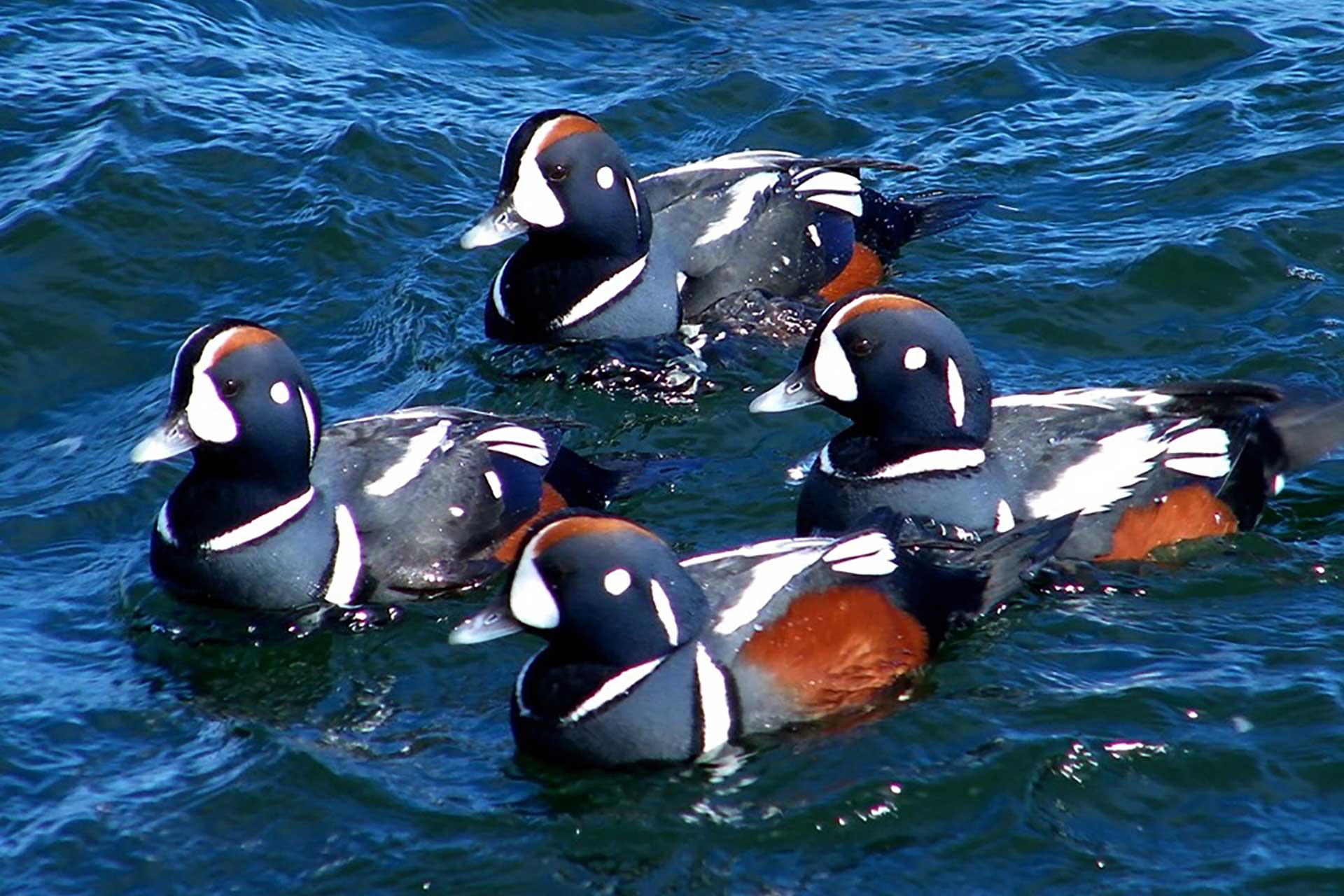Related Publications
Bond, J. and D. Esler. 2008. Bill entanglement in subcutaneously-anchored radio transmitters on Harlequin Ducks. Wilson Journal of Ornithology 120:599-602. https://doi.org/10.1676/07-078.1
Bond, J. C. and D. Esler. 2006. Nutrient acquisition by female Harlequin Ducks prior to spring migration and reproduction: evidence for body mass optimization. Canadian Journal of Zoology 84:1223-1229. https://doi.org/10.1139/z06-111
Bond, J. C., D. Esler, and K. A. Hobson. 2007. Isotopic evidence for sources of nutrients allocated to clutch formation by harlequin ducks. Condor 109:698-704. https://doi.org/10.1093/condor/109.3.698
Bond, J. C., D. Esler, and T. D. Williams. 2008. Breeding propensity of female harlequin ducks. Journal of Wildlife Management 72:1388-1393. https://doi.org/10.2193/2007-241
Bond, J. C., S. A. Iverson, N. B. Maccallum, C. M. Smith, H. J. Bruner, and D. Esler. 2009. Variation in breeding season survival of female harlequin ducks. Journal of Wildlife Management 73:965-972. https://doi.org/10.2193/2008-236
Cooke, F., G. J. Robertson, R. I. Goudie, and W. S. Boyd. 1997. Molt and the basic plumage of male harlequin ducks. Condor 99:83-90. https://doi.org/10.2307/1370226
Cooke, F., G. J. Robertson, C. M. Smith, R. I. Goudie, and W. S. Boyd. 2000. Survival, emigration, and winter population structure of Harlequin Ducks. Condor 102:137-144. https://doi.org/10.1093/condor/102.1.137
Esler, D. and J. C. Bond. 2010. Cross-seasonal dynamics in body mass of male Harlequin Ducks: a strategy for meeting costs of reproduction. Canadian Journal of Zoology 88:224-230. https://doi.org/10.1139/Z09-135
Gowans, B., G. J. Robertson, and F. Cooke. 1998. Behaviour and chronology of pair formation by Harlequin Ducks Histrionicus histrionicus. Wildfowl 48:135-146. https://wildfowl.wwt.org.uk/index.php/wildfowl/article/view/1021
Hunt, B., and R. Ydenberg. 2000. Harlequins Histrionicus histrionicus in a Rocky Mountain watershed I: Background and general breeding ecology. Wildfowl 51:155-168. https://wildfowl.wwt.org.uk/index.php/wildfowl/article/viewFile/1088
LeBourdais, S. V., R. C. Ydenberg, and D. Esler. 2009. Fish and harlequin ducks compete on breeding streams. Canadian Journal of Zoology 87:31-40. https://doi.org/10.1139/Z08-135
Regehr, H. M. 2003. Survival and movement of postfledging juvenile harlequin ducks. Wilson Bulletin 115:423-430. https://doi.org/10.1676/03-031
Regehr, H. M. 2011. Movement rates and distances of wintering harlequin ducks: implications for population structure. Waterbirds 34:19-31. https://doi.org/10.1675/063.034.0103
Regehr, H. M. and M. S. Rodway. 2003. Evaluation of nasal discs and colored leg bands as markers for Harlequin Ducks. Journal of Field Ornithology 74:129-135. https://doi.org/10.1648/0273-8570-74.2.129
Regehr, H. M., C. M. Smith, B. Arquilla, and F. Cooke. 2001. Post-fledging broods of migratory Harlequin Ducks accompany females to wintering areas. Condor 103:408-412. https://doi.org/10.1093/condor/103.2.408
Robertson, G. J., and F. Cooke. 1999. Winter philopatry in migratory waterfowl. Auk 116:20-34. https://doi.org/10.2307/4089450
Robertson, G. J., F. Cooke, R. I. Goudie, and W. S. Boyd. 1998. Moult speed predicts pairing success in male harlequin ducks. Animal Behaviour 55:1677-1684. https://doi.org/10.1006/anbe.1997.0724
Robertson, G. J., F. Cooke, R. I. Goudie, and W. S. Boyd. 1998. The timing of arrival and moult chronology of Harlequin Ducks Histrionicus histrionicus. Wildfowl 48:147-155. https://wildfowl.wwt.org.uk/index.php/wildfowl/article/view/1022
Robertson, G. J., F. Cooke, R. I. Goudie, and W. S. Boyd. 1998. The timing of pair formation in Harlequin ducks. Condor 100:551-555. https://doi.org/10.2307/1369723
Robertson, G. J., F. Cooke, R. I. Goudie, and W. S. Boyd. 2000. Spacing patterns, mating systems, and winter philopatry in Harlequin Ducks. Auk 117:299-307. https://doi.org/10.1093/auk/117.2.299
Rodway, M. S. 2006. Have winter spacing patterns of harlequin ducks been partially shaped by sexual selection? Waterbirds 29:415-426. https://doi.org/10.1675/1524-4695(2006)29[415:HWSPOH]2.0.CO;2
Rodway, M. S. 2007. Timing of pairing in waterfowl II: Testing the hypotheses with Harlequin Ducks. Waterbirds 30:506-520. https://doi.org/10.1675/1524-4695(2007)030[0506:TOPIWI]2.0.CO;2
Rodway, M. S. 2013. Pair-bond defense relates to mate quality in Harlequin Ducks (Histrionicus histrionicus). Waterbirds 36:189-198. https://doi.org/10.1675/063.036.0208
Rodway, M. S. and F. Cooke. 2001. Effect of food availability on arrival and departure decisions of Harlequin Ducks at diurnal feeding grounds. Condor 103:870-874. https://www.jstor.org/stable/1370123
Rodway, M. S. and F. Cooke. 2002. Use of fecal analysis to determine seasonal changes in the diet of wintering Harlequin Ducks at a herring spawning site. Journal of Field Ornithology 73:363-371. https://doi.org/10.1648/0273-8570-73.4.363
Rodway, M. S., H. M. Regehr, J. Ashley, P. V. Clarkson, R. I. Goudie, D. E. Hay, C. M. Smith, and K. G. Wright. 2003. Aggregative response of Harlequin Ducks to herring spawning in the Strait of Georgia, British Columbia. Canadian Journal of Zoology 81:504-514. https://doi.org/10.1139/z03-032
Rodway, M. S., H. M. Regehr, and F. Cooke. 2003. Sex and age differences in distribution, abundance, and habitat preferences of wintering Harlequin Ducks: Implications for conservation and estimating recruitment rates. Canadian Journal of Zoology 81:492-503. https://doi.org/10.1139/z03-025
Smith, C., F. Cooke, and R. I. Goudie. 1999. Ageing Harlequin Duck Histrionicus histrionicus drakes using plumage characteristics. Wildfowl 49:245-248. https://wildfowl.wwt.org.uk/index.php/wildfowl/article/view/1057
Smith, C. M., F. Cooke, G. J. Robertson, R. I. Goudie, and W. S. Boyd. 2000. Long-term pair bonds in Harlequin Ducks. Condor 102:201-205. https://doi.org/10.1093/condor/102.1.201
Smith, C. M., R. I. Goudie, and F. Cooke. 2001. Winter age ratios and the assessment of recruitment of Harlequin Ducks. Waterbirds 24:39-44. https://doi.org/10.2307/1522241
Smith, C. M., P. G. Trimper, L. J. Bate, S. Brodeur, W. K. Hansen, and M. Robert. 2015. A mist-net method for capturing harlequin ducks on rivers. Wildlife Society Bulletin 39:373-377. https://doi.org/10.1002/wsb.530
Torres, R., F. Cooke, G. J. Robertson, and W. S. Boyd. 2002. Pairing decisions in the Harlequin Duck: Costs and benefits. Waterbirds 25:340-347. https://doi.org/10.1675/1524-4695(2002)025[0340:PDITHD]2.0.CO;2
Wright, K. G., G. J. Robertson, and R. I. Goudie. 1998. Evidence of spring staging and migration route of individual breeding harlequin ducks, Histrionicus histrionicus, in Southern British Columbia. Canadian Field-Naturalist 112:518-519. https://doi.org/10.5962/p.358461
